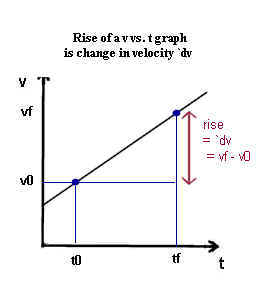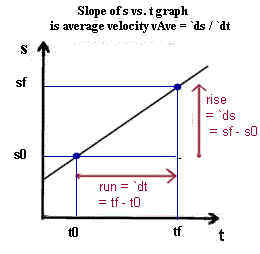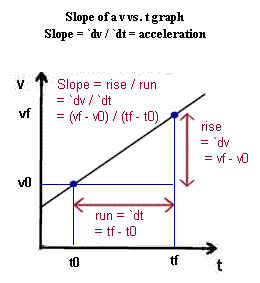`dt
v0
vf
(v0)
![]()
![]()
![]()
![]()
`dv
vAve
m
a
`ds
![]()
![]()
`dt
F
![]()
![]()
`dW
`dp
`dt |
v0 |
vf |
|
(v0) |
`dt | |||||||||||||||||
|
|
|
|
|
||||||||||||||||||
|
||||||||||||||||||||||
|
`dv |
|
vAve |
|||||||||||||||||||
m |
|
a |
|
|
`ds |
|||||||||||||||||
|
|
|
|
|||||||||||||||||||
`dt |
|
F |
|
|||||||||||||||||||
|
|
|||||||||||||||||||||
`dW |
||||||||||||||||||||||
`dp |
||||||||||||||||||||||
`dv = vf - v0 triangle: `dv is change in velocity, v0 and vf are initial and final velocities.
`dv=vf-v0 basic example: If an automobile increases its velocity from 10 meters / second to 15 meters / second its velocity changes by +5 meters / second. Here we have
v0 = 10 m/s, vf = 15 m/s so
`dv = vf - v0 = 15 m/s - 10 m/s = 5 m/s.
`dv graphical representation: If initial velocity is v0 and final velocity is vf the on a graph of v vs. t the change in velocity is represented by the rise of the graph from v0 to vf.
 :
:
vAve : The definition of average velocity is vAve = `ds / `dt. If acceleration is uniform then vAve is also equal to the average of initial and final velocities: vAve = (vf + v0) / 2.
vAve basic example: If we move through a displacement of 300 miles in 6 hours then our average velocity is 300 miles / (6 hours) = 50 miles / hour. If our average velocity for a 3-hour trip is 40 miles / hr we move 3 hr * (40 miles / hr) = 120 miles. If we travel 100 milres at an average of 20 miles/hr then we require 100 mile / (20 miles / hr) = 5 hours to complete the trip.
vAve graphical representation: vAve = `ds / `dt. On a graph of s vs. t we see that `ds, the change in position, is represented by the rise of the graph while `dt = tf = t0 is represented by the run, so that vAve = `ds / `dt is represented by the rise / run = slope of the graph.

`ds = vAve * `dt. vAve = `ds / `dt, the average rate of change of position. From algebraically rearrangemet of this definition we see that `ds = vAve * `dt and that `dt = `ds / vAve.
`ds basic examples: If we move through a displacement of 300 miles in 6 hours then our average velocity is 300 miles / (6 hours) = 50 miles / hour. If our average velocity for a 3-hour trip is 40 miles / hr we move 3 hr * (40 miles / hr) = 120 miles. If we travel 100 milres at an average of 20 miles/hr then we require 100 mile / (20 miles / hr) = 5 hours to complete the trip.
`ds graphical representation: Since vAve = `ds / `dt is represented by the slope of the s vs. t graph, we see that `ds = vAve * `dt is equal to the product of the slope and the time interval `dt.

a triangle: a is acceleration, which is the rate of change of velocity. In the case of uniform acceleration we have a = `dv / `dt. Algebraic rearrangement of this definition gives us `dv = a `dt or `dt = `dv / a. We also note that `dv = change in velocity, `dv = vf - v0.
acceleration basic examples: If it requires 10 seconds to increaese the velocity of an automobile by 15 meters per second, then the average acceleration during that time is aAve = `dv / `dt = 15 m/s / (10 s) = 1.5 m/s^2. If the velocity of a ball rolling down an incline changes at the uniform rate of 2 m/s / s, or 2 m/s^2, then its acceleration is 2 m/s^2; in 5 seconds its velocity will change by `dv = a `dt = 2 m/s^2 * 5 s = 10 m/s.
Acceleration represented graphically: On a graph of v vs. t we see that the rise of the graph represents `dv = vf - v0, the change in velocity. The run represents `dt = tf - t0, the change in clock time. Acceleration is the rate of change a = `dv / `dt, which is represented by rise / run = `dv / `dt = slope. Thus acceleration is represented by the slope of a v vs. t graph.

F triangle: The net force Fnet acting on a system of mass m is equal to the product Fnet = m a of the mass and the acceleration. Algebraic rearrangement leads to the forms a = Fnet / m, which tells us the acceleration expected from net force Fnet acting on mass m, and m = Fnet / a, from which we can find the mass of an object by observing the acceleration that results from a given force.
F Basic Examples: To accelerate a mass of 100 kg at 3 m/s^2 requires a net force of Fnet = 100 kg * 3 m/s^2 = 300 Newtons. A person on the Earth with a mass of 75 kg experiences a force of Fgrav = 75 kg * 9.8 m/s^2 = 735 Newtons as a result of the gravitational force exerted by the Earth. If we wish to accelerate a rocket with mass 10,000 kg upward at 20 m/s^2 the net force must be 10,000 kg * 20 m/s^2 = 200,000 Newtons; this net force is the sum of the rocket's upward thrust and the 98,000 N downward force exerted by gravity so the thrust must be 200,000 Newtons + 98,000 Newtons.
know what the symbols in each formula stand for, conditions under which they apply, canonical example, graph or picture
problems are experiential--they bring the stuff to life and enhance analytical abilities, maybe even lead to self-examined life though it doesn't seem to work for physicists
| Motion | Force | Work/Energy | Momentum | Formulation of Uniformly Accelerated Motion |
| `dv = vf - v0 vAve = (vf + v0) / 2 `ds = vAve * `dt a = `dv / `dt |
Fnet = m a | `dWnet = Fnet * `ds KE = .5 mv^2 `dWnet = `dKE `dWnet = `dWcons + `dWnoncons |
`dp = Fnet * `dt | `ds = (vf + v0) / 2 * `dt vf = v0 + a `dt `ds = v0 `dt + .5 a `dt^2 vf^2 = v0^2 + 2 a `ds
|
Forces
Rubber band
Pendulum
Mass on incline
Atwood's machine
Block across floor
Forces in collisions
Work/Energy
Free fall
Incline
Rubber Band
`dKE = `dWnet (block across floor)
Cheerios
Gas tank
Conservative forces
`dKE + `dPE +`dWdiss = `dWappl
Collisions
Reference frames
Two dimensions
Next pages: Satellites, Rotation, SHM